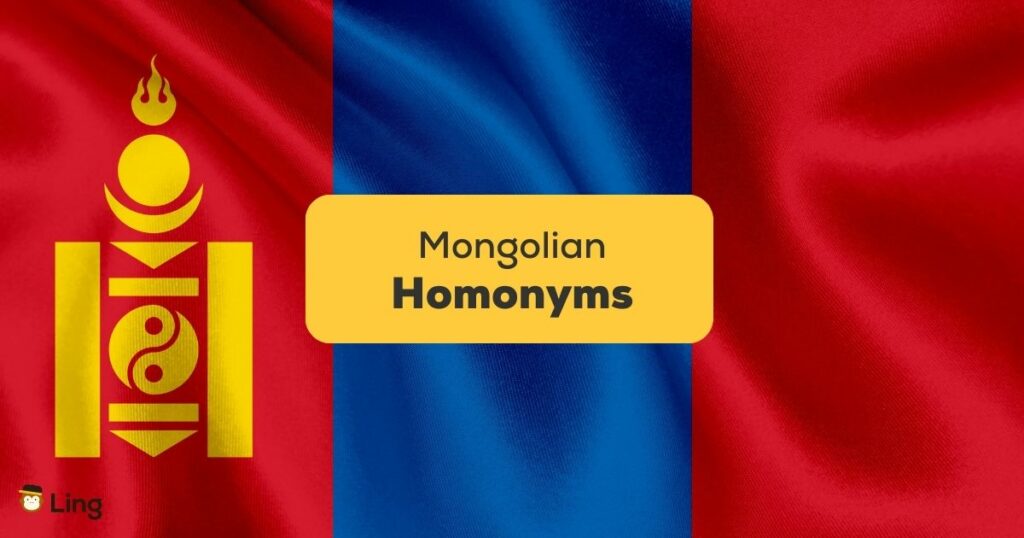Ever played word games that left you pleasantly puzzled? Get ready for a linguistic adventure as we explore Mongolian homonyms! These sneaky words sound the same but carry different meanings, adding a dash of mystery and a sprinkle of charm to the Mongolian language. Let’s unravel the delightful enigma of Mongolian homonyms together!
But before that, let us make sure that we are on the same page on what homonyms are. Let’s begin by giving color to its definition!
What Are Homonyms?
Imagine language as a playful puzzle! Homonyms are the mischievous twins of words—they look and sound the same but play different roles in meaning. Think ‘bat‘ (flying creature) and ‘bat‘ (sports gear)! They’re like wordy chameleons that keep us guessing.
Homonyms also have subcategories: homophones and homographs. The question is this—what even are they? Get ready to untangle the fun of homonyms, where spelling and sound collide in a delightful language game!

Homophones
Meet the wordy twins: Homophones! They’re words that love playing dress-up, sounding exactly the same but having different meanings. Think ‘peace’ and ‘piece’—they’re like sneaky soundalikes with unique personalities! So, next time you’re writing, watch out for these tricky pals who might switch places and add a twist to your sentences!
Homographs
They’re words that look the same on paper but play different roles in meaning. Think ‘lead’ (to guide) and ‘lead’ (metal); they’re like secret agents with a double life! And watch out for words like ‘tear,’ which can mean ‘to rip’ or ‘a drop of emotion.’ They’re the ultimate spelling switcheroos that keep you on your toes!
What Are Mongolian Homonyms?
Mongolian homonyms are linguistic gems, like playful riddles that have shaped the rich tapestry of Mongolian culture. Picture this: words that sound alike but dance to different meanings, like a secret language shared by insiders. As nomads roamed and winds whispered across the vast steppes, these homonyms emerged, reflecting the resourceful spirit of the Mongolian people.
Remember, the word twins sound alike but live different lives in meaning. Keep your ears sharp and context handy to uncover their playful secrets. From ‘агаар’ (sky/mountain) to ‘Ороо’ (to go/mouth), it’s a language maze full of surprises.

Tips For Understanding A Homonym
Since homonyms may either sound or look the same, grasping the meaning of what’s being described can be a problem. So, how can we be sure of what is being talked about?
The go-to checklist to be confident in understanding and using a homonym is to pay attention to context. Yes, context, context, and context. We can avoid being unsure by picking up or dropping some clues about the context of a sentence. This is our main equipment for cleaning the fog of confusion!
Mongolian Homonyms
Now let us look at some examples of Mongolian homonyms that we can use creatively:
| English Translation | Mongolian Homonym | Pronunciation |
| Sky / Mountain | Агаар | Agar |
| Head / Mine | Толгой | Tolgoi |
| Right / West | Баруун | Baruun |
| To drive / River | Яваа | Yavaa |
| To go / Mouth | Ороо | Oroo |
| Four / Winter | Дөрөв | Döröv |
| White / Shovel | Цагаан | Tsagaan |
| Arm / Hand | Гар | Gar |
| Moon / Month | Сар | Sar |
| Good / Sweet | Сайн | Sain |
Who knew language could be this playful? Mongolian homonyms add a dash of whimsy to words and a sparkle to conversations. From mountains to skies, heads to mines, it’s a linguistic rollercoaster that keeps you guessing. It’s like words look or sound the same but differ in color (meaning) depending on the context—like a chameleon!
As you journey through Mongolia’s wordy wonderland, remember: it’s not just about what you say, but the mischievous dance of meanings that make language truly enchanting. So, go ahead, embrace the homonyms, and let your words take you on an adventure beyond the ordinary.

FAQs About Mongolian Homonyms
Are homonyms exclusive to the Mongolian language?
No, homonyms exist in many languages, but Mongolian’s extensive use of homonyms is particularly fascinating.
How do Mongolian speakers distinguish between different meanings of homonyms?
Context, intonation, and familiarity with the subject matter play crucial roles in deciphering homonym meanings.
Can the same homonym have completely unrelated meanings?
Yes, some homonyms in Mongolian can have vastly different meanings, often showcasing the language’s versatility.
Are homonyms more common in spoken or written Mongolian?
Homonyms are prevalent in both spoken and written forms of Mongolian, contributing to the overall linguistic complexity.
What role do homonyms play in traditional Mongolian literature?
Homonyms add layers of depth to traditional Mongolian poetry and prose, requiring readers to explore multiple interpretations.
Continue Your Mongolian Journey With Ling!
Dive deeper into the rich language of Mongolia with a fun, interactive, and effective app! Look no further than the Ling app—your passport to a language adventure that’s as thrilling as a nomadic journey across the steppes! From Mongolian culture to polite Mongolian phrases, Ling provides every learning resource: blogs, lessons, games, and more!
Why settle for dull textbooks when you can conquer Mongolian with the coolest language app in town? The Ling app’s secret sauce? It sprinkles learning with magic! From mastering ‘агаар’ (sky/mountain) to ‘гар’ (arm/hand), you’ll be speaking like a true nomad in no time.
With bite-sized lessons, interactive games, and native speakers as your guides, you’ll unravel the mystery of Mongolian while having a blast. So why study with the Ling App? Because it’s not just learning—it’s exploring, discovering, and laughing your way to linguistic triumph! You can get Ling for FREE on the Play Store or App Store!


































































